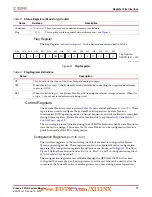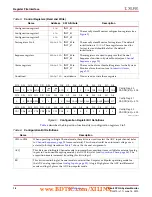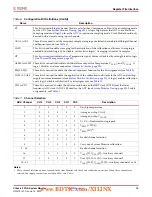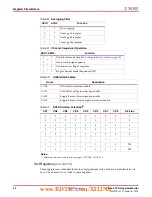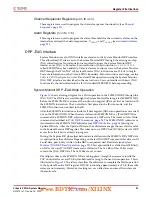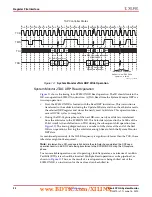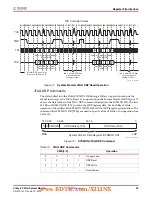
24
Virtex-6 FPGA System Monitor
UG370 (v1.1) June 14, 2010
Register File Interface
It is also possible to enable the auxiliary analog input channel pre-configuration of the
FPGA, allowing external analog voltages (on the PCB) to be monitored using the JTAG
TAP before configuration. The auxiliary channels are enabled by writing
0001h
to DRP
address
02h
. This address lies within the read-only status register address space and
normally holds the result of a V
CCAUX
measurement. However, a write to this address
enables the auxiliary inputs.
Note:
This function only works prior to configuration. Post configuration, these inputs must be
explicitly instantiated in the design.
DRP Arbitration
Because the DRP registers are accessed from two different ports (interconnect and JTAG
TAP) access must be carefully managed. An arbitrator has been implemented to manage
potential conflicts between the fabric and JTAG port. Arbitration is managed on a per
transaction basis (a transaction is a single Read/Write operation to the DRP). The
arbitration rules are as follows:
•
A JTAG transaction cannot be interrupted by the fabric. The fabric transaction is
queued by the arbitrator until the JTAG transaction has finished, and then the fabric
transaction is completed.
•
A JTAG transaction cannot interrupt a fabric transaction already in progress. As soon
as the fabric transaction is finished, then the JTAG transaction is completed.
Three status signals are provided to help manage access through the interconnect when the
JTAG port is also being used.
JTAGBUSY
This signal becomes active during the update phase of a DRP transaction through the JTAG
TAP. The signal resets when the JTAG SYSMON DR transaction is completed. Each
Read/Write to the SYSMON DR is treated as an individual transaction. If DRP access
initiates through the interconnect port when JTAGBUSY is High, then the arbitrator
queues this request for a Read/Write through the fabric. DRDY does not go active until
JTAGBUSY transitions Low and the interconnect transaction is completed. A second DRP
access through the fabric must not be initiated until the DRDY for the initial access
becomes active and indicates the Read/Write was successful. If an interconnect access is in
progress when a JTAG DRP transaction initiates, the interconnect access is completed
before the JTAG transaction.
JTAGMODIFIED
Whenever there is a JTAG Write (JTAG Reads typically occur more often) to any register in
the DRP, the application (FPGA) must be notified about the potential change of
configuration. Thus, a signal called JTAGMODIFIED transitions High after a JTAG Write.
A subsequent DRP Read/Write resets the signal.
JTAGLOCKED
In some cases, it is simpler for the JTAG user to take DRP ownership for a period by
locking out access through the interconnect. This is useful in a diagnostic situation where
a large number of DRP registers are modified through the JTAG TAP. When a
JTAGLOCKED request is made, the JTAGLOCKED signal transitions to an active High.
The signal remains High until the port is unlocked again. No read or write access is
possible via the DRP fabric port when the JTAGLOCKED signal is High. The
www.BDTIC.com/XILINX








